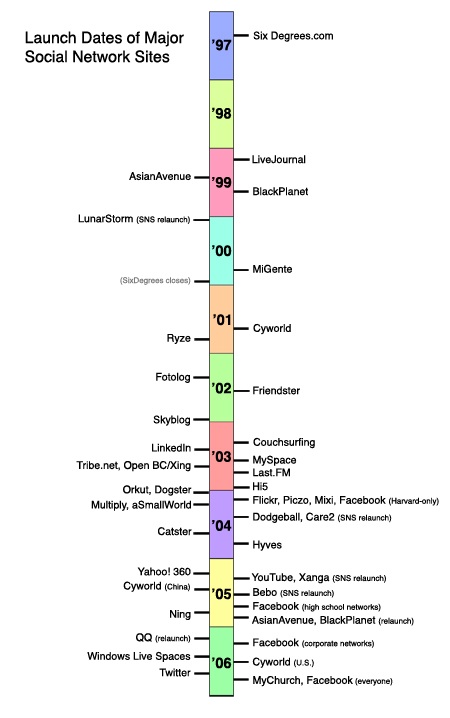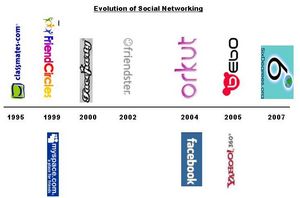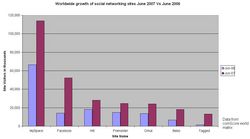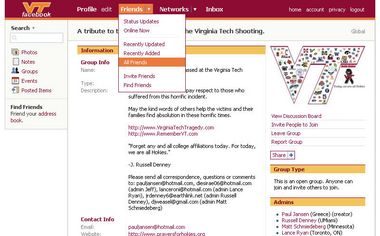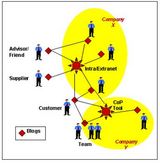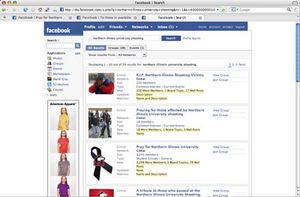(Group 4) -- Robynn, Djurdjica, Daniel, Joel, Karey
Contents
- 1 The Evolution of Social Networking
The Evolution of Social Networking
Team Information
Team Members
- Daniel
- Djurdjica
- Joel
- Karey
- Robynn
Team Contacts
- Daniel - spoonie_@hotmail.com
- Djurdjica - dracunic@hotmail.com
- Joel - joeyeisenkirch@hotmail.com
- Karey - karey_p@hotmail.com
- Robynn - rmjones@ucalgary.ca
Technological Results of Social Networking Websites
Problem Statement:
- Social networking websites are evolving.
Arguments:
- What has it evolved out of and from where?
- Where is it now?
- Where could it be in the future?
Conclusion Statement:
- Social networking websites connect people, compete and evolve technologically to attract new users and keep old ones.
What has it evolved out of and from where?
The first social networking website was created in 1995 called “Classmates.com” developed by Randy Conrads. The primary focus of Classmates was to allow its members to find and connect with old friends and colleagues from school, university and the Military. Classmates did not become profitable until 2001 due to the gradual transition and awareness of social networks. The business model for Classmates is based on the user generated advertising and content (UGC). Where the end users simply develop and create online spaces for the purpose of attracting other users for its enjoyment. Up until around 2001 when Classmates became profitable only a small handfull of social networking sites exististed these being FriendsCircles developed in 1999 by Jonathan Bishop, Myspace developed in February 1999 by Thomas Anderson and Christopher DeWolfe, Faceparty was launched in 2000 by Dave Bamforth and Phineas Kibbey. Then in March 2002 Friendster was launched by Jonathan Abrams. January 2004 saw the launch of Orkut by google worker Orkut Buyukkokten shortly after in February 2004 Facebook was launched by Mark Zuckerberg. In January 2005 Bebo was launched by Michael and Xochi Birch, and in July 2005 the site underwent an extensive relaunch. Finally, Yahoo launched its own site called “Yahoo 360” in March 2005. Most recently the world has yet another site launched in January 2007 by Kevin Bacon called “Six degrees.org”.
Where is it now?
People all over the world, from various ways of life take part in a form of communication which seems to have taken over our world, that is: social networking websites. Over the last decade websites such as myspace, bebo or facebook have transformed the way in which we interact with other people. It is now easier than ever before to keep in touch with a loved one who has moved half way across the world, or a friend you haven't seen since grade school. Social networking websites have given us the ability to find, share, and talk with anyone we wish to and this shows monumental growth in the impact technology has on the social world. Throughout the evolution of social networking there have been two websites which have been most popular and most prevalent amongst users; those sites are: Myspace and Facebook.
Advantages & Disadvantages
After looking at the overall uses of these two social networking websites, it is easy to see the comparisons between the two-despite the difference of five years between being created--they both offer a place to share information about yourself and photos, as well as a way to search out new people. So why is it then that people create new sites? Why hasn’t everyone simply joined MySpace and stayed limited to the one website? The answer to this is not easily found, because it in part has to do simply with personal preferences, but as you search further the differences between these two websites become more apparent. A vast difference between these two websites is the users which it attracts. While MySpace is used by many different types of people, it is most popular with teens and young adults; it also appeals most to people interested in music and pop culture.
The more distinct features MySpace offers are: the ability to customize one’s profile by changing the background, the colors, and the music on their profile. One of the most substantial uses of MySpace is for bands or musicians, people can find new music or musicians and listen to samples of their music, this has created a whole new way of experiencing music using the internet. Facebook on the other hand shows a more practical and typical way of socializing. There is a standard profile layout which can really only be changed in terms of the information it presents rather than its actual appearance. Though it is possible to locate music and feature it, the selection is quite often limited to the more popular and well knows musicians. This shows a variation in the market being targeted.
As social networking websites become more common, the types of people using them becomes more widespread; therefore these websites have had to alter and become more open to all people. This is where the greatest difference between MySpace and Facebook can be seen, while MySpace attracts a specific market of teens and young people interested in music, Facebook appeals to a much larger and broader group of individuals, this can explain in part the new draw and overwhelming success of Facebook.
Current Applications
Social networking sites like Facebook and MySpace have led to a whole new way of remembrance and mourning. This phenomenon of memorials has been most prevalent on Facebook with its base in the university world, and ability to create social groups and clubs. Often classmates and friends of the deceased will create a site in remembrance of loved ones lost, or of a tragic occurrence, similar to roadside shrines commonly associated with traffic deaths.
Example: Memorials
After the school shootings at Virginia Tech and Northern Illinois University these memorial sites attracted a large amount of media attention and membership growth. This membership growth started with the affected student body, as there is often a social need to be together and mourn collectively as is regularly done at a funeral, wake, or candle light vigil. The groups were often used to organize vigils or prayer sessions, or eventually to raise money for the needed causes of families in grief, this is especially common among networking sites specifically for police officers or firefighters. However, soon, membership grew to members of other schools as a show of solidarity with grieving students at such institutions. Especially interesting is the role of members and survivors of past school shootings in contacting communities where emergencies have just taken place and being supportive from long distances, as is exemplified by the Hokies (Virginia Tech) for Huskies (Northern Illinois) phenomenon. There was also a mass movement of changing one’s profile picture to remember those lost in the tragedy, and a logo of the NIU sports team logo upon a black ribbon became the common sign of sympathy much like one would wear a ribbon upon one’s clothes in the real world. Some have criticized what they see as the cheapening of mourning by such simple acts on sites by people with little if any connection to the passed away.
Often the personal social network pages of those lost became places to leave messages of remembrance and love for the deceased, and served the mass media as instant obituary-like information on the victims. In fact, in Britain the prestige and attention of memorial sites on Bebo have led some to blame social networking for encouraging copycat like suicides. On the other hand, the pages of the perpetrators, who had committed suicide after the murders, was often mined and scoured for clues to the questions of why and how an individual could be led to commit such horrendous acts. Kimveer Gill’s profile on VampireFreaks.com is an example and was restricted and then removed shortly after he committed the murder and shootings at Dawson College in Montreal. Often the names of the victims and perpetrators are for a time banned from publication by the media, but are often available on social networking sites first.
However, the initial use of social networking sites in such situations is to warn others to stay away and to check on friends and family to make sure they are alright and not among those injured or killed. Traffic can be enormous in the aftermath of the word getting out, and users will often put a message online such as “I’m Ok” to reassure others. Since phone lines often need to be kept open for emergency calls, and it can be difficult to phone all of one’s friends quickly, social networking sites can be used effectively in this regard.
Future Applications
The emergence of social networking mourning and dedication sites has led to a growth in memorial web sites organized and prepared by funeral homes in the remembrance of many deceased. Since many sites do not take down profiles or memberships without the member’s permission, often a person’s account will continue long after one has passed. There is some speculation that in the future such profiles could be linked as family trees and serve as genealogies and eternal memorials in much the same way we might have the tombstones of all the members of a family in a common location.
Privacy and Security
False Identities The problem with Facebook and Myspace.com encompasses the very problem with the internet in general. Everything is subject to everybody and everything. These sites are unbridled in their ability to distribute and allocate your personal information. To start your account to begin with, the basic information entered is completely based on the honour system. Like Myspace.com, there is a lack of verified information, and therefore, a lack of provable identities. A free-for-all for perverts and undisclosed companies trying to pirate your information.
- “In consideration of your use of the Site, you agree to provide accurate, current, and complete information about you as may be prompted by any registration forms on the Site (“Registration Data”)[1]
User Conduct
Some of the most humorous and unmonitored selections from the “User Conduct” on Facebook. Two Things: Harvesting your information for spam, or impersonation. Completely unmonitored. [2] “You agree not to use the Service or the Site to:
- “impersonate any person or entity, or falsely state or otherwise misrepresent yourself, your age or your affiliation with any person or entity;”
- “upload, post, transmit, share or otherwise make available any unsolicited or unauthorized advertising, solicitations, promotional materials, "junk mail," "spam," "chain letters," "pyramid schemes," or any other form of solicitation;”
Two Things: Harvesting your information for spam, or impersonation. Completely unmonitored. [3]
Unmonitored Information
Application developers can view your information if your friend has it. Invasiveness of privacy and unwarranted sharing of information.
- “Facebook's Web site and lengthy application terms of service curiously fail to mention something rather important. In addition to providing the application developer access to most of your private profile data, you also agree to allow the developer to see private data on all of your friends too”
- “Many Facebook users set their profiles to private, which stops anyone but their friends from seeing their profile details. This is a great privacy feature that can protect users from cyberstalkers and is completely gutted by the application system. To restate things--if you set your profile to private, and one of your friends adds an application, most of your profile information that is visible to your friend is also available to the application developer--even if you yourself have not installed the application.” [4]
Facebook example
Jones, Harvey and Jose Hiram Soltren. “Facebook: Threats to Privacy.” December 15, 2005. < http://ocw.cput.ac.za/NR/rdonlyres/Electrical-Engineering-and-Computer-Science/6-805Fall-2005/8EE6D1CB-A269-434E-BEF9-D5C4B4C67895/0/facebook.pdf >. (accessed November 18, 2008).
- “Privacy on Facebook is undermined by three principal factors: users disclose too much, Facebook does not take adequate steps to protect user privacy, and third parties are actively seeking out end-user information using Facebook… Specifically, university administrators are using Facebook for disciplinary purposes, firms are using it for marketing purposes, and intruders are exploiting security holes” (Jones and Soltren 1).
- Conflicting interests in the Facebook Phenomena. “University administrators or police officers may search the site for evidence of students breaking their school’s regulations. Users may submit their data without being aware that it may be shared with advertisers. Third parties may build a database of Facebook data to sell. Intruders may steal passwords, or entire databases, from Facebook’ (Jones and Soltren 4).
Example
Hazard and Death Caused by Myspace
The 13 Year old, Megan Meier hung herself in her closet because of harassment on Myspace.com. It turned out to be a mother down the street—pretending to be Josh Evans—to see what Megan said about her daughter. Says a lot about the loose net-laws that monitor identity on these sites.
- “Ron and Tina Meier have said their daughter's death [Megan Meier] was the result of the rapid decline of her online relationship with a person she believed to be a boy named "Josh Evans," who first flattered the self-conscious girl and then taunted her… In a police report filed last year, the Meiers' neighbor, Lori Drew, said she and an 18-year-old employee created a fake MySpace profile for Josh Evans so she could monitor what Megan Meier was saying about Drew's daughter” [5](was on Doctor Phil)
Myspace Design Features
- Customized Layout
- Flash/video Headers
- Custom Backround
- Animated Profile
- Extended Network Banner
- 10 Image Slideshow
- Downloadable Image Elements
- Code for Message, Comment and Bulletin Posting
- Content Editing
- Creative Consultation
Top 10 Facebook applications
- Super Wall- Allows users to write messages, post pictures and post videos
- Fun Wall- Tagging of photos and it also allows youtube videos
- Top Friends- Allow the user to post their top 32 friends along with photos
- Video- Post videos on you wall and send videos to friends
- Superpoke- let your friends know that you are thinking of them
- Flixter movies- allows you to see what movies your friends like and compare it to your interests
- Are you interested???- allows people to ask the question...are you interested?
- iLike- lets you add music and videos to your profile.
- X me- allow your friends to do things to you. ex. hit a button on your page and give you a hug.
- Bumper Sticker- create a bumber sticker and stick it to friends walls
Conclusion
The evolution of social networking ranges from sites that reunite and allow past and present friends to communicate, to sites that focus on charity work and doing something good for the community. However, more and more social networking sites have become involved in different aspects of society; the concept of allowing individuals to communicate has not been forgotten but it has essentially evolved to understand how we can help society and so something worthwhile with the technology that we take for granted.
References & External Links
Daniel
1.http://en.wikipedia.org/wiki/FaceBook
2.http://en.wikipedia.org/wiki/Virginia_Tech_massacre
3.http://en.wikipedia.org/wiki/Dawson_College_shooting
4.http://www.niuremembers.com/
5.http://www.firefighternation.com/group/canadianfallenfirefightersfoundation
6.http://www.sptimes.com/2006/08/27/Tampabay/_Online_death_dialogu.shtml
7.http://www.wired.com/techbiz/startups/news/2008/05/tributes?currentPage=all
8.http://abcnews.go.com/Business/story?id=3046434&page=1
9.http://www.thestar.com/printArticle/290941
10.http://www.guardian.co.uk/news/blog/2007/apr/17/facebookmemori
11.http://www.guardian.co.uk/technology/2008/aug/07/socialnetworking.myspace
12.http://www.popandpolitics.com/2008/02/18/mourning-on-the-social-networks/
13.http://www.news.com.au/story/0,23599,23098127-23109,00.html
14.http://www.reuters.com/article/pressRelease/idUS126055+25-Feb-2008+PRN20080225
Djurdjica
1. http://www.nfistudios.com/news/a-brief-history-of-social-networking-sites/
2. http://ecompost.wordpress.com/2008/02/24/evolution-of-social-networking-to-the-present-day/
3. http://en.wikipedia.org/wiki/Social_networking
4. http://many.corante.com/archives/2006/11/12/social_network_sites_my_definition.php
5. http://social-networking-websites-review.toptenreviews.com/
6. http://www.internetartizans.co.uk/social_action_networks
7. http://www.internetartizans.co.uk/blogtags/social_networks
8. http://news.bbc.co.uk/2/hi/programmes/click_online/7318288.stm
9. http://www.nmc.org/evolution-communication
10. http://blogs.techrepublic.com.com/tech-news/?p=1145
11. http://jcmc.indiana.edu/vol13/issue1/boyd.ellison.html
12. http://blogs.techrepublic.com.com/tech-news/?p=1145
13. http://blogs.cisco.com/consumer/comments/social_networking_evolution_vertical_or_horizontal/
14. http://www.deepjiveinterests.com/2006/09/17/citizendium-an-evolution-in-social-networking/
15. http://wk.typepad.com/weblog/2007/03/social_networki.html
Joel
1. http://www.facebook.com/terms.php
2. http://news.cnet.com/8301-13739_3-9854409-46.html
Karey
1. http://profile.myspace.com/index.cfm?fuseaction=user.viewprofile&friendid=81159429
4. http://myspace.com/thefeatures
5. http://customizedfacebook.com/index.html
6. http://newestonthenet.com/top-10-most-popular-facebook-applications/
7. http://antiques-collectables-auction-news.com/2007/12/23/special-features-of-facebook/
Robynn
1. http://www.ncpc.org/topics/by-audience/parents/social-networking-websites/
2. http://social-networking-websites-review.toptenreviews.com
3. http://www.bloggingstocks.com/2008/05/05/battle-of-the-brands-myspace-vs-facebook/
4. http://www.myspace.com/index.cfm?fuseaction=misc.aboutus
5. http://knowledge.wharton.upenn.edu/article.cfm?articleid=1463
6. http://mashable.com/2006/08/25/facebook-profile/
